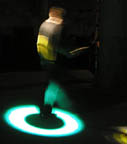
Stories Stitched Together "on the fly"
When Ghosts Will Die, a performance-installation that utilizes multi-sensory elements such as sound, video, light, and text controlled by motion-tracking technology, tells the story about the dangers of nuclear proliferation. Inspired by the play, "Copenhagen", by Michael Frayn, it explores the use of non-linguistic elements in the service of making poetry and telling stories. The artists and programmers involved on the project include Steve Gibson, Dene Grigar, Will Bauer, Jim Andrews, and John Barber.
"When Ghosts Will Die" involves one-two performers and envisions the space as a 3D grid simultaneously within a central computer and a physical performance space. The performers move through this environment and evoke the multi-sensory elements with hand-held tracking devices and in so doing interact with these elements through three potential phases of nuclear proliferation: 1) Disharmony, 2) Destruction, and 3) Disintegration. These three phases are intended to evoke the first nuclear explosion, the "Trinity" test in New Mexico on July 16, 1945, that took place just weeks before the nuclear bombs exploded over Hiroshima and Nagasaki, Japan.
Using the tracking device, the performers can move through the space choosing the element they wish to utilize for telling the story. In this way, the story takes on a rhapsodic quality: it is literally stitched together "on the fly" and changes wtih each telling. The mood of the space is designed to match the phase that the performers reach. Disharmony, for example, offers slightly discordant sounds that increasingly give way to cacophony, as well as video footage representing growing belligerence. Destruction sees the dropping of the bombs and corresponding sounds of buildings falling into rubble. The final phase, Disintegration, takes performers to the motif of the work: that the destruction derived from these weapons will be so complete that even "ghosts will die," an allusion to Michael Frayn's "Copenhagen" that sits at the heart of this project.
The story is meant to shock those participating into a deeper awareness of the horrors of nuclear warfare. Politically speaking, the work's message "that the development and deployment of weapons of mass destruction not only test a country's power but also its humanity" speaks to artists' "responsibility to envision alternative futures... and shape the way people think, live, and interact" (Edward Shanken). [via]
Originally posted on networked_performance by jo



